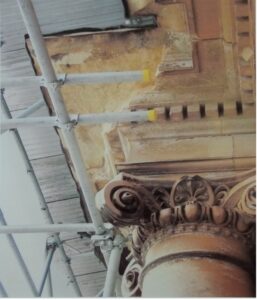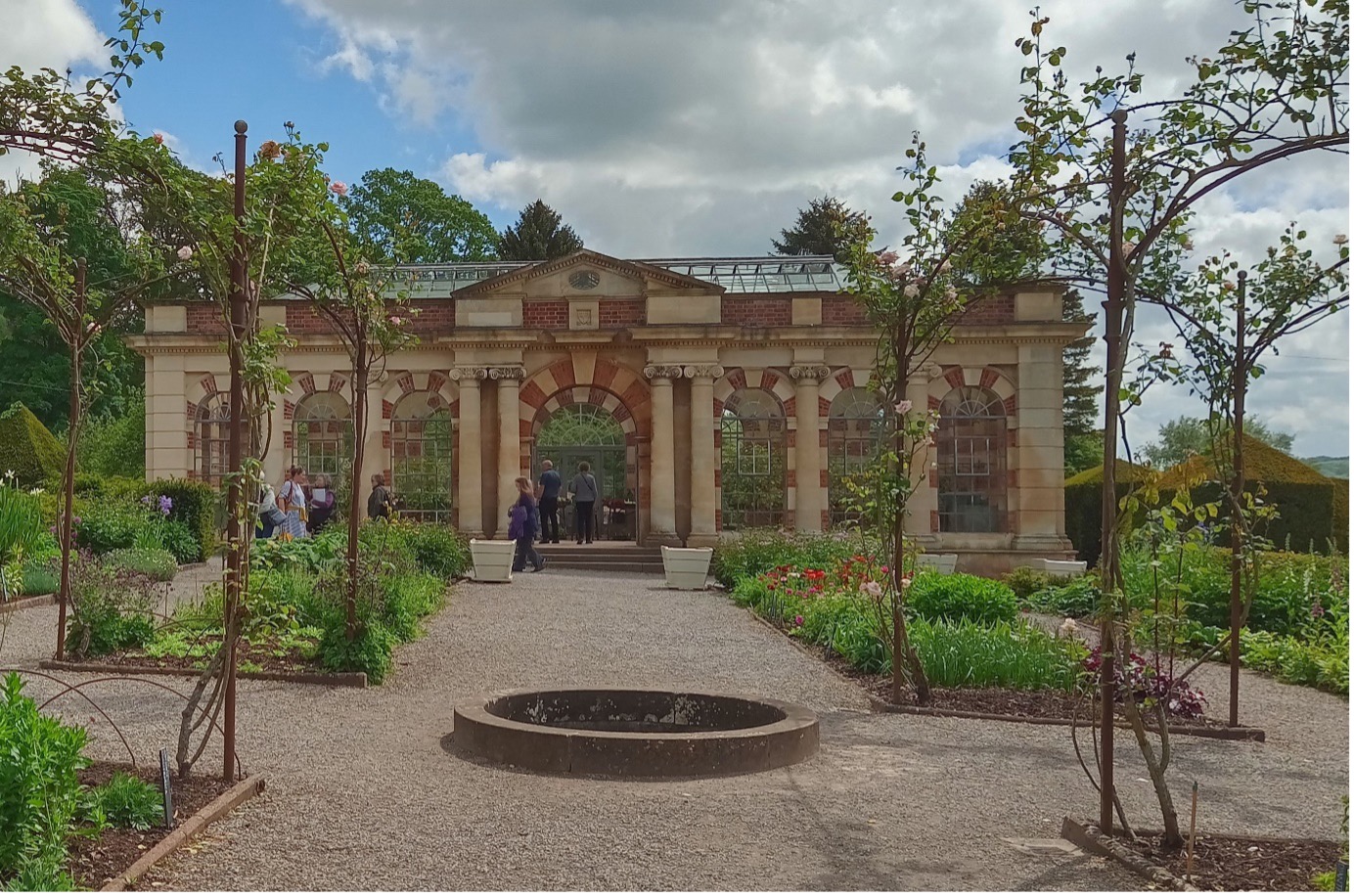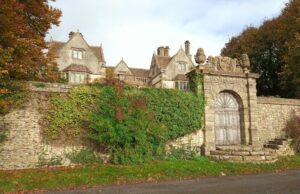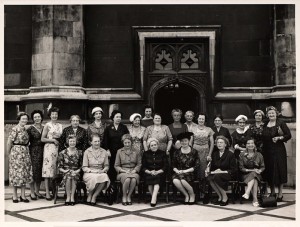Researching and writing about Reggie Cooper has been an absorbing task over the last few years, not least during the pandemic. Impossible to visit archives in person, online resources and emails allowed it to chug along. And then, later, the joy of being able to visit sources and sites in person (West Horsley Place, in Surrey, home to Reggie’s mother between 1921 and 1931; Hidcote Manor in Gloucestershire and Houghton Hall in Norfolk, were particularly memorable). After several redrafts and some agonising over which of the many images to use as illustrations, the article has been submitted for publication.
The Blue Plaque scheme and Honor Balfour’s former London home
Last year I submitted Honor Balfour (1912-2001)’s former London home in Kensington for the award of a Blue Plaque to commemorate her many years there. It’s a long process with several stages of evaluation so it may be some while before the decision is made. I knew from my conversations with Honor what the drawing room had looked like but it was not until 2022 that I saw the exterior of the house. It faces a private square but in June 2022 it was open under London Open Gardens weekend. The planting, and possibly the design, will have changed since Honor lived in the crescent but it was great to get a sense of the view and the green space she would have enjoyed, a possible antidote to a very busy life.
Tyntesfield Orangery revisited
The now fully restored neo-classical orangery at Tyntesfield, Wraxall in Somerset is a joy to see, and a very different sight to the one I saw in 2006 when I wrote about it for my Architectural Association dissertation on historic orangeries. Then in a parlous state: weeds sprouting from interior walls; protective roofing; decayed stonework supported by scaffolding

A view of one of the portico capitals. © Helen Langley, 2006.
Commissioned by Antony Gibbs (1841-1907), designed by the now largely-overlooked Arts and Crafts architect and designer, Walter Cave (1863-1939), with youthful exuberance, if perhaps insufficient technical experience to foresee subsequent problems. Tyntesfield was Cave’s first garden, and his third commission from Gibbs who had interests in Devon, Cave’s home county. Gibbs’ two Devon projects, one of which included the monument in Ottery St Mary to mark Queen Victoria’s Diamond Jubilee, are mentioned in a article by Judith Patrick published by the Devon Gardens Trust here.
The Tyntesfield scheme was sited in the re-modelled kitchen garden of 1890-1910 and within walking distance from the house, using the then new stone-flagged path. A destination for family and visitors as they circuited the gardens and grounds. An allusion, perhaps, to eighteenth century notions of entertainment.
The 1897 orangery graces the Jubilee Garden its name again referencing Victoria’s Diamond Jubilee. The complex comprises the Lady Garden (now known as the Lady Wraxall’s garden); loggia, cutting garden, head gardener’s office; rooms for tools and potting, storing apples, and the boiler (the distance of which from the orangery was once thought to have contributed to the latter’s original problems); walled kitchen garden and range of glasshouses. Nearby is a bothy, also by Cave.
From the outset the site was intended to be ‘on display’ – a formalised productive garden with an ornamental role. Large oranges, oleanders and camellias were cultivated in the orangery which also served as an occasional reception room. (The galvanised steel window frames are twentieth century). After the Second World War it became a greenhouse. Back in the early 2000s this Grade 11* building’s future was far from secure; it seemed on the point of collapse. Tyntesfield’s acquisition by the National Trust in 2002 was a game changer. It ushered in plans for restoring the estate. The orangery which had been placed Historic England’s Buildings at Risk list in 2008 was finally rescued in an imaginative collaborative programme with funding by the HLF and the Commercial Education Trust. The latter funded a three-year training course with students from the Architectural Stone Conservation course at City of Bath College. Nimbus Conservation Ltd were the principal contractors.
A detailed account of the project is available here.
On the day of our visit in May 2024 the orangery was a glorious sight; the scent of the citrus trees delicious.

A view across the cutting garden. © Helen Langley, 2024
Many years ago, when writing about political houses and gardens, I was given access to two of Cave’s later schemes, both in Oxfordshire; The ‘neo-William and Mary’ Wharf (then divided into two properties) in Sutton Courtenay and the exterior and gardens of the Tudor style Ewelme Manor. c.1910. The Wharf was of particular interest because it had been commissioned in 1912 by the Prime Minister’s wife, Margot Asquith, later Countess of Oxford and Asquith (1864-1945), in the forlorn hope of improving the amount of quiet time spent with her husband (sadly for her it’s where Asquith wrote many of his love letters to Venetia Stanley, later Montagu (1887-1948). The detailing at Tyntesfield, especially the Lady Garden, loggia and the head gardener’s office, is reminiscent of both Ewelme’s and High Walls in Headington Oxford, c. 1912.
The BBC at 100 Symposium
Helen has been invited to attend The BBC at 100 Symposium, to be held from 13 to 15 September 2022 in Bradford at the National Science and Media Museum and online. As a member of the session on Politics and Current Affairs, she will be speaking about the contributions of Honor Balfour (1912-2001) and Stephen Bonarjee (1912- 2003) - a wonderful opportunity to draw their careers to the attention of a wide audience.

Broadcasting House: detail from 2018 image
Helen’s latest projects include preparing to attend The BBC at 100 Symposium as a member of the session on Politics and Current Affairs where she will be speaking about the contributions of Honor Balfour (1912-2001) and Stephen Bonarjee (1912- 2003).
The Symposium is being held from 13 to 15 September 2022 in Bradford at the National Science and Media Museum and online.
The invitation to speak brings a wonderful opportunity to draw the careers of Honor Balfour and Stephen Bonarjeeto the attention of a wide audience and hopefully encourage researchers to explore further the careers of these two innovatory figures.
A visit to Royal Crescent – the London home of Honor Balfour
Years ago Honor Balfour described to me the décor of her London home in Royal Crescent, Kensington, acquired in the early post-war years long before the area became fashionable. So it was great when the London Gardens Trust Open Squares weekend in June brought the chance to visit Royal Crescent’s square.
Years ago Honor Balfour described to me the décor of her London home in Royal Crescent, Kensington, acquired in the early post-war years long before the area became fashionable. Sometimes I have visualized Honor at the peak of her broadcasting career, in the 1950s and 1960s, setting out to appear on one of her radio or television programmes, so it was great when, in June, the London Gardens Trust Open Squares weekend brought the chance to visit Royal Crescent’s square. It’s now somewhat changed since Honor’s day, but in the years before she rented a weekend cottage in the Cotswolds it must have been a welcome green space.
Reginald (Reggie) Cooper (1865-1965): Closing stages of research reveal new insights
The search of archival resources for information about Reggie Cooper is coming to a close. Several sources consulted since last year have provided some fascinating insights into his personality, and his design of the orangery for Sir Philip Sassoon (1885-1939).
The search of archival resources for information about Reggie Cooper is coming to a close. Several sources consulted since last year have provided some fascinating insights into his personality, and his design of the orangery for Sir Philip Sassoon (1885-1939).
Chief among these are the papers of the architect Oliver Hill (1887-1968) in the RIBA’s collection at the V&A Museum. Hill had been commissioned by Reggie’s mother, Lady Cooper, to remodel 1 Upper Terrace, Hampstead. Reggie’s letters and postcards (some adorned with drawings) to his old friend, Christopher Hussey (1889-1970), Country Life’s architectural editor, who lived at Scotney Castle in Kent (archive held by the National Trust; copies very kindly provided by the House and Collections Manager) and, the most recently consulted, the archive of Sir Philip Sassoon relating to Trent Park. This small but wonderful archive, held at Houghton Hall, Norfolk and very kindly made available by Lord Cholmondeley, Sassoon’s great nephew, provided crucial details about how Reggie came to design the orangery and enabled me to understand more fully how this delightful building sat within the gardens and wider landscape.
In other cases it was a case of ruling out some archives as sources. Fostered by reading Allyson Hayward’s biography of Norah Lindsay (1873-1948), an old friend of Cooper’s, hopes were high that the Whitbread archive at Southill Park might be useful (Lindsay was Madeline Whitbread’s sister) but the archivist couldn’t find anything.
At the Royal Horticultural Society (RHS)’s Lindley Library, the absence of Reggie’s name in the society’s list of members and list of library users confirmed my view that he was more of an architect and designer manqué, content to follow the tastes of Johnston and Lindsay in his garden schemes. But I may be proved wrong. Access has yet to be granted to the archive of Lawrence Johnston (1871-1958) at Hidcote, held by the National Trust.
Reginald (Reggie) Cooper: Continuing the Quest
With archives presently closed because of the pandemic, resuming research into the career of the restorer of ancient houses and maker of gardens rose to the top of my list of projects because much of it could be conducted from my desk. Reggie Cooper first caught my attention in 2006; in between other projects I continued my ‘quest for Reggie’, returning to it full time in the summer of 2020 after completing the article on Honor Balfour.

Cold Ashton Manor, near Chippenham, Reggie Cooper’s second renovation project. Photographed October 2020.
With archives presently closed because of the pandemic, resuming research into the career of the restorer of ancient houses and maker of gardens rose to the top of my list of projects because much of it could be conducted from my desk. Reggie Cooper first caught my attention in 2006 as the amateur architect of the delightful neo-classical orangery for the politician Sir Philip Sassoon (1888-1939) at Trent Park. In between other projects I continued my ‘quest for Reggie’, returning to it full time in the summer of 2020 after completing the article on Honor Balfour.
Using internet and printed sources and boosted by access to family material, correspondence with those with stories to share or working on related topics, and information generously shared by June Davey, historian at West Horsley Place, in Surrey (which Reggie’s mother, Lady (Marion) Cooper owned between 1921 to 1931) I’ve revised my lists of the houses in which Reggie lived and those he knew through his friendships with other enthusiastic restorers of dilapidated old houses. There’s still more research to do, once the archives at the Royal Institute of Architecture (RIBA) and the Royal Horticultural Society (RHS) reopen to researchers but a more comprehensive narrative of his life is emerging.
Dame Irene Ward: Soldiers of Oxfordshire Museum Exhibition Contribution

Women MPs elected in the 1959 General Election. Image reproduced with the permission of Parliamentary Archives, PUD/8/32. http://www.parliament.uk/archives
A (very minor) contributor to an exhibition at the Soldiers of Oxfordshire Museum in Woodstock. Scheduled for Spring 2020 the opening was postponed by the pandemic until October 2020 but shortly afterwards new national lockdown restrictions were introduced.
The invitation to contribute information arose from my past work on Dame Irene Ward. The campaign by Dame Irene (later Baroness Ward of North Tyneside, 1895-1980) for the release of Special Operations Executive (SOE) files and the commissioning of an official history of the organisation began in the mid1950s when she was Conservative MP for Tynemouth. It was partly inspired by the refusal to allow access to SOE files while researching her history of the First Aid Nursing Yeomanry, F.A.N.Y Invicta (1955) which includes a chapter on members who became agents in ‘The Org’: SOE.
As a lifelong campaigner against injustice (most recently for equal pay for women, culminating in the 1954 Act), she was driven to champion those whose exploits remained buried in closed files; overshadowed by films about famous agents; memoirs by the former head of SOE’s French section, Colonel Maurice Buckmaster (1902-1992) among others, and speculative histories. A study by the historian M R D Foot was eventually published in 1966. Her contribution to the commissioning may not have been as great as she believed but it was not inconsiderable.
Honour Balfour’s Broadcasting Career
With the publication of the article 'What Honor did next, the pioneering broadcasting career of Honor Balfour (1912-2001)', in the Journal of Liberal Democrat History, a very enjoyable period spent researching her remarkable life comes to a close.

Honor regularly appeared on Town Forum but Denmark was a rare overseas location. More usual were towns in the area covered by the BBC’s Midlands Home Service division. ©Radio Times/Immediate Media.
With the publication of the article on Honor’s broadcasting career, a very enjoyable period spent researching her remarkable life comes to a close.
Back in 2018 I only knew she’d been involved in one or two radio programmes. The first of what became many visits to the BBC Written Archives Centre pointed to her far greater involvement, especially in the early years of current affairs broadcasting.
At the British Library where BBC audio visual material is viewed, I was captivated by the sight of Honor in her prime, appearing on Press Conference in April 1959, a member of the panel interviewing Eleanor Roosevelt (1884-1962).
Honor’s pioneering time at Picture Post and at the BBC have undeservedly slipped into history’s byways. It’s time she was restored to her rightful place.
BBC History Research: ‘Honor Balfour: the first significant woman in BBC Current Affairs’
In July 2019 as a guest contributor to the BBC history research website an introduction to Honor’s career at the BBC. The full article can be found here.
